Text



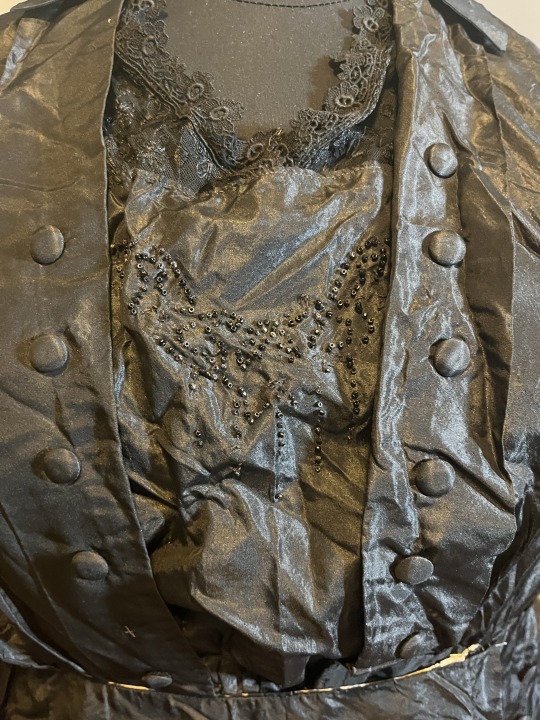
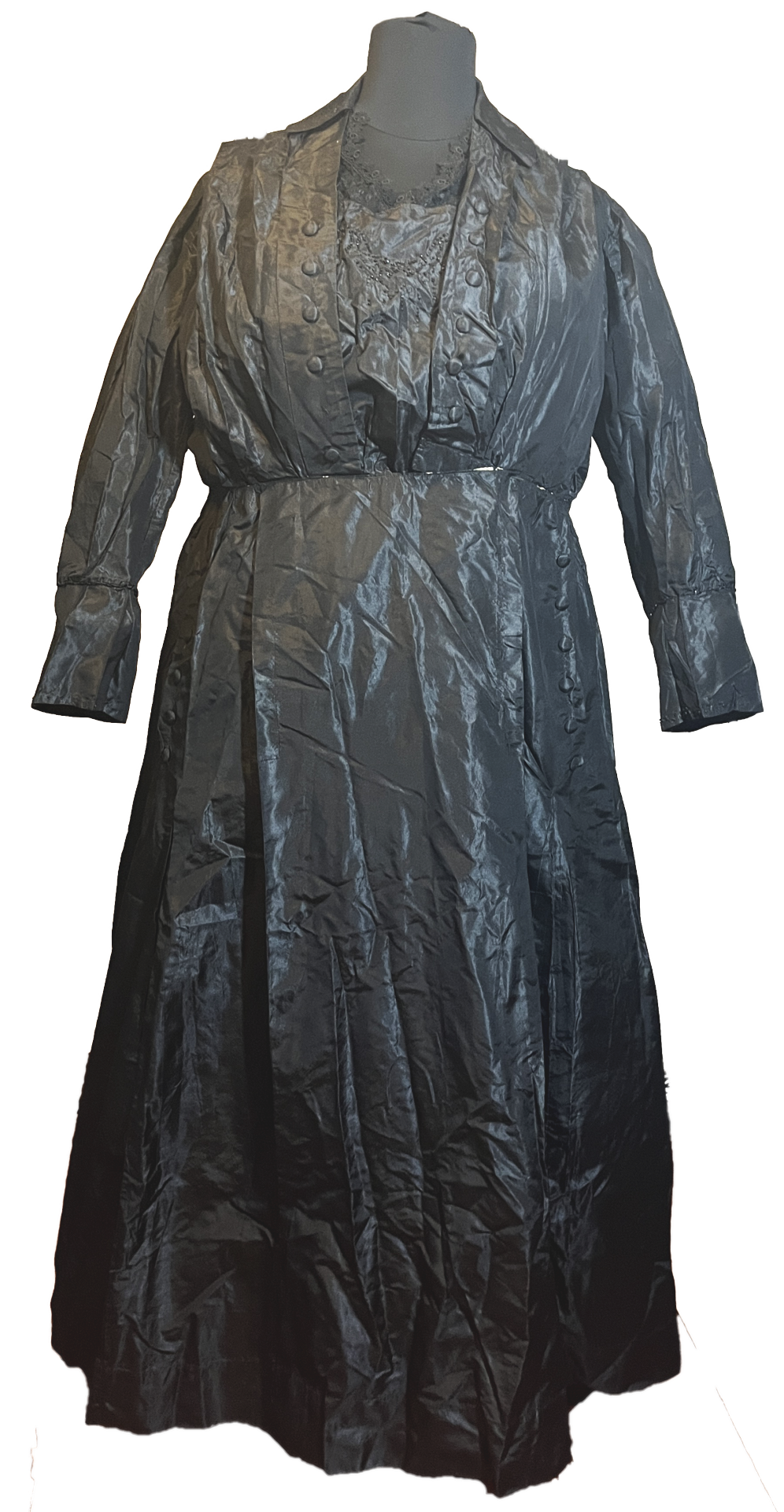
The two newest patterns that I have in testing right now, based on antique plus-size garments...
c. 1909 eleven-gore polka-dotted cotton day skirt
The size as-is is a 37”/94cm waist with 60”/152cm+ hips, and ungathered it’s a 46.5”/118cm waist. It was made for a very short person, so I’ve provided the original length (32”/81cm) as well as an extended version (40”/102cm) on the pattern for whatever you need. On Etsy here.
c. 1915-17 silk day dress with beading
This has a 60” (152cm) bust and 45.5” (116cm) waist and was made for a relatively tall person. On Etsy here.
Both are now up on Etsy!
49 notes
·
View notes
Text
Why. Why would Instagram change the font so subtly. Are they trying to drive me off the wall insane. One of my accounts has the original font and the other one changed with no warning. I look at a paragraph and immediately know something’s different but then I zoom in and I can’t figure out what’s changed. I’m having a meltdown please save me. Why did the letters need to be slightly more square and with a nanometer more space between them. I-
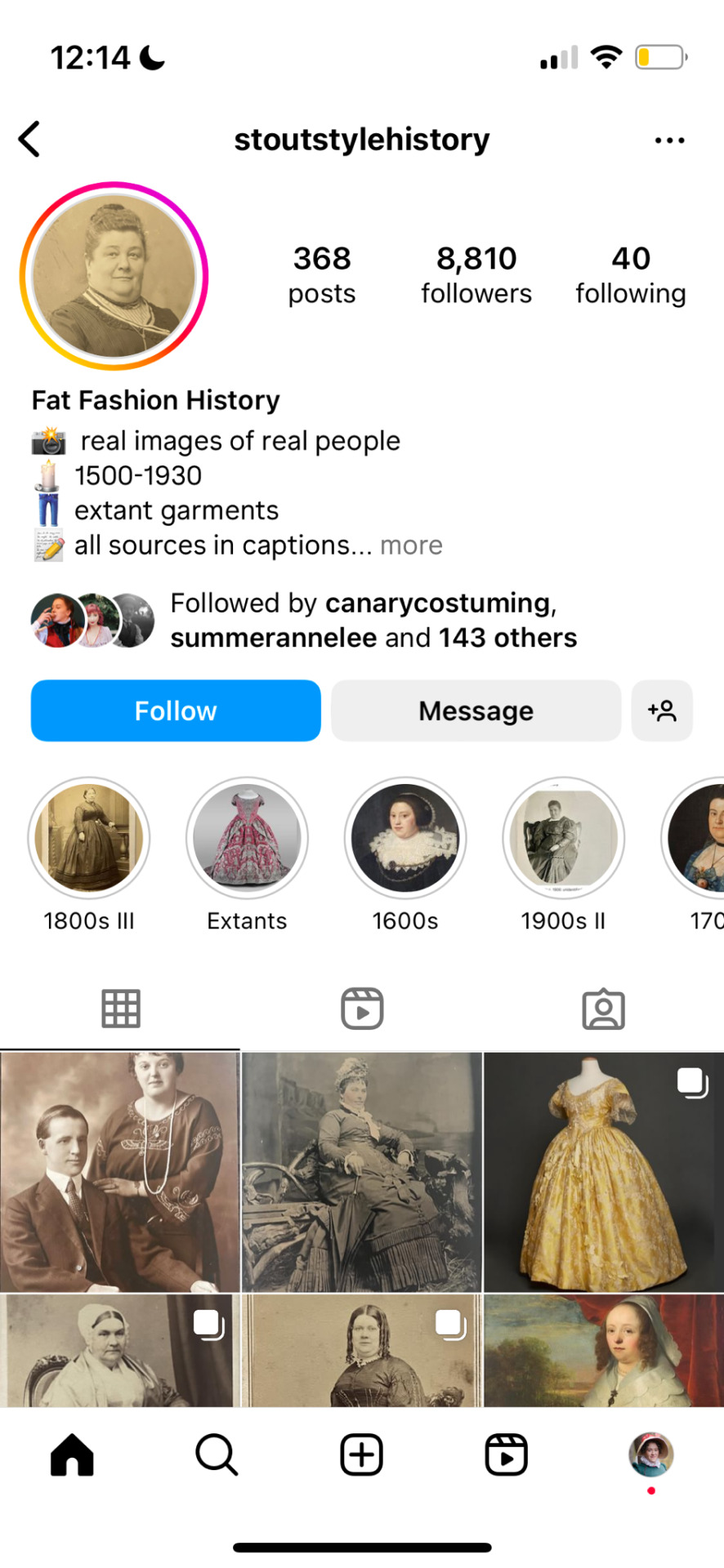

please. Are these fonts different i’m going insane
24 notes
·
View notes
Text
so many words about historical men's corsetry
(This got way too long to send via Discord -- Dangimace in the Renegade Bindery server asked about men's corset sewing/resource recs so here is my half-assed and non-exhaustive rundown. Most of my historical sewing is focused on fashions of the UK, US, and Europe for the second half of the 18th century and first half of the 19th century, so that bias is reflected here; also disclaimer overall that "menswear"/"womenswear" are socially constructed categories and real people's bodies have always looked a wider variety of ways than fashion and other social forces would dictate. I sew historical garments with enthusiastic disregard for the historical gender binary and I'm barrel-chested, thick-waisted, and narrow-hipped no matter what I'm wearing.)
Onward, lads!
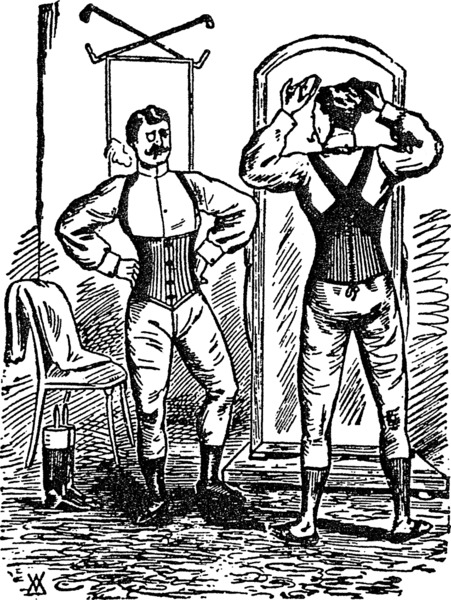
Ok wrt men's corsetry: there's a whole lot of fogginess around how historical men's corsets were constructed for a bunch of annoying reasons but that means there's lots of possibilities to explore in pattern drafting and project planning. Stays and other stiffened body-shaping garments have a whole complex conceptual relationship to the body basically as soon as they start appearing. 16th and 17th century garments do a whole lot of shaping (both compressing and building up) for men and women alike, but things really kick off in the 18th century in terms of the symbolic weight placed on stays and (later) corsets. Whole lot of stuff about gender, social class, race, fatness, morality, etc. getting projected onto these garments. So I'm a little leery about people taking obviously satirical illustrations of fashion-victim dandies or Gross Corpulent Libertines getting laced into corsets as truthful and indicative of the way men were really dressing -- scurrilous gossip and exaggeration are both a pain to sift through if we want to know which men wore corsets, what kind, and why.
In the very late 18th/early 19th century corsets were part of the repertoire for achieving highly fashionable shapes in menswear. (Along with a whole lot of padding.) They weren't mandatory for all dudes, but for fashion-forward dandies and equally fashion-forward military men, male corsets/stays were definitely a thing. The whole Romantic-era pigeon-breasted, narrow-waisted silhouette can be emulated by shapewear worn beneath the clothes, pads in the garments themselves, or both; in addition to waist reduction it helped to maintain smooth visual lines underneath close-fitting garments.
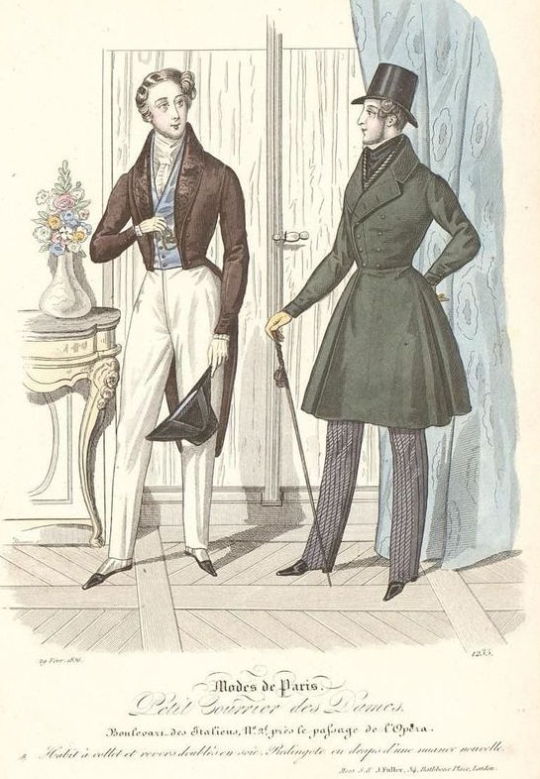
(look at these minxy 1830s dudes and their tiny waists)
As the century goes on the desired menswear silhouette becomes boxier and less fitted, and male corsetry recedes into the background; we start to see patents and advertisements for men's corsetry, so they still seem to have been worn, but there's a lot more language around vigorous manly athleticism and supporting the structures of the body. It can be hard to tell whether a particular piece is intended to be worn primarily for some medical purpose or for its perceived aesthetic benefits. This is giving me such flashbacks to trying to find post-surgical compression garments.
(Side note: there's also a vigorous tradition of fetishist writing about corsetry all through the 19th century, in fairly mainstream channels, which is fascinating. Due to the relatively private and deeply horny nature of fetish tightlacing we don't necessarily know as much about what those same letter-writers may have "really" worn at home, but I hope they were having fun.)
I've seen very few specifically men's corsetry patterns from historical pattern-makers-- not even really big names like Redthreaded. I sewed my 19thc menswear corsets from the men's underbust pattern in Laughing Moon Mercantile #113 which afaik is speculative rather than reproducing a specific historical garment, but it's not too different from the women's late-19th-century underbust patterns in the same pattern pack.
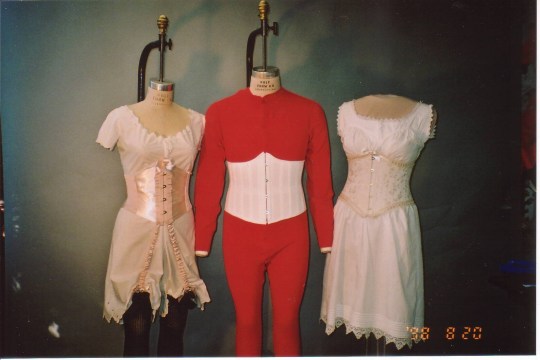
(image credit: LMM)
However, a lot of underbust and waist-cincher patterns from more general historical patternmakers could be made suitable with some minor alterations. Here I'd also rec books like Jill Salen's Corsets: Historical Patterns And Techniques and Norah Waugh's Corsets & Crinolines, though their focus is definitely on womenswear and you need to be relatively comfortable scaling up or drafting from pattern diagrams.
The structural features and desired results for a man's corset are pretty much the same as any other corset (back support, compression in some areas, etc.) even when the desired silhouette is different; commercially-created patterns are drafted with the expectation of certain bodily proportions so like with all corset-sewing it's important to make a mockup for fitting purposes. (I ended up liking one of my mockups so much I finished the process and made it a whole separate corset.) I don't know much about this area but I seem to see a lot more belt-and-buckle closures and criss-crossing straps in corsets designated as being for men -- this might be a byproduct of gendered differences in how people got dressed, but it might be nothing.
There's some weird and wonderful historical examples, both extant and in images -- I appreciated this post at Matsuzake Sewing, "A Brief Discussion Of Men's Stays", and its accompanying roundup of images on Pinterest though the tone wrt historical fetishwear corsets in the blog post is a little snippy. I really want to make a replica of Thomas Chew's 1810s corset (which you can read more about here at the USS Constitution Museum) but it incorporates stretch panels made with a shitload of metal springs and I'm not ready for all the trial and error trying to replicate that.

(image credit: USS Constitution Museum Collections)
There's a pretty rich vein of modern men's corset patterns which seem like they could be easily pattern-hacked for historical costuming purposes, like these with shoulder straps from Corsets By Caroline or DrobeStoreUpcycling's waist cincher which also looks like it could be altered pretty easily to cinch with straps and buckles like some 19thc men's corsetry does. This pattern for a boned chest binder in vest form by KennaSewLastCentury is also really cool but I didn't get a chance to sew it pre-top-surgery. (I think I've also seen someone who made a chest-compressing variation on Regency short stays, but I can't find it now.)
In general a lot of underbust and waist-cincher patterns should work just fine for silhouette-shaping without much bust/hip emphasis -- my usual resource for free corset patterns (Aranea Black) recently took down all her free patterns but they're definitely still circulating out there. For general fashion purposes the sky is the limit and there are a lot of enthusiastic dudes in corsets out there. This Lucy Corsetry round-up shows a variety of modern corsetiers' styles designated as being for men or more masculine silhouettes (including a SUPER aspirational brocaded corset with matching waistcoat made by Heavenly Corsets that I'd love to sew a historical spin on) and you can see some commonalities and possibilities for body-shaping.
I can also give some more general corset-sewing resources but I'm very much in the learning process here and I'd love any recs or input from people more experienced in pattern-drafting and corset-sewing.
94 notes
·
View notes
Text

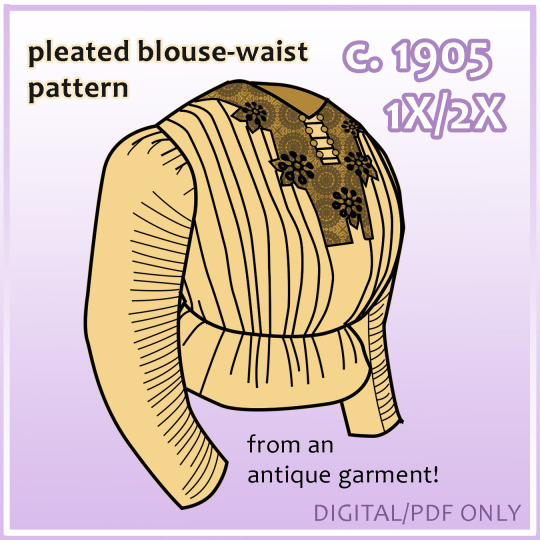
Open for testers! 📣 This lovely 1905-6 cotton sateen blouse waist is a 49” (124cm) bust, and the waist is free as the pleating isn’t secured except at the back (it ties shut/gets tucked into the skirt). It’s got a lace yoke, box-pleats at front and back, and gorgeous pin-tucked sleeves. ✨ Forgive me for making it yellow in the thumbnail, but I wanted to showcase the details lol. DM me if you’re interested in testing.
Available on Etsy here!
28 notes
·
View notes
Text





The two newest patterns that I have in testing right now, based on antique plus-size garments...
c. 1909 eleven-gore polka-dotted cotton day skirt
The size as-is is a 37”/94cm waist with 60”/152cm+ hips, and ungathered it’s a 46.5”/118cm waist. It was made for a very short person, so I’ve provided the original length (32”/81cm) as well as an extended version (40”/102cm) on the pattern for whatever you need. On Etsy here.
c. 1915-17 silk day dress with beading
This has a 60” (152cm) bust and 45.5” (116cm) waist and was made for a relatively tall person. On Etsy here.
Both are now up on Etsy!
49 notes
·
View notes
Text
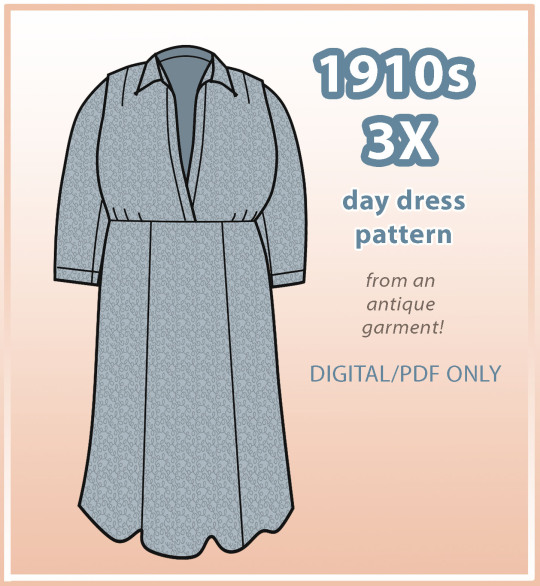
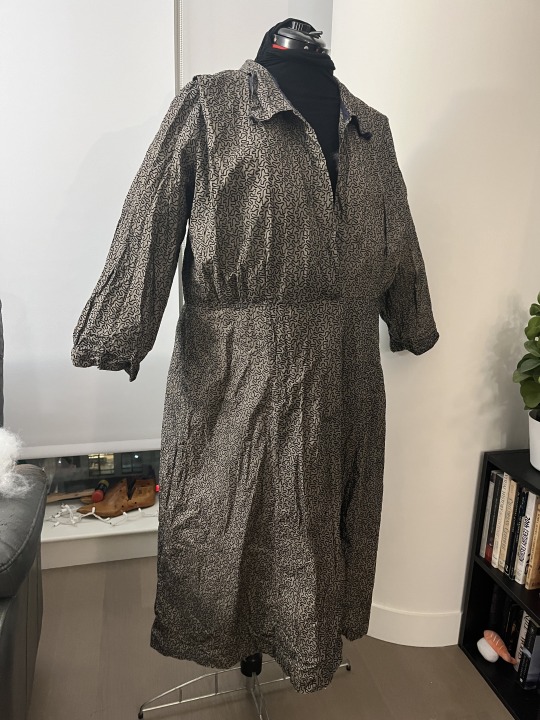


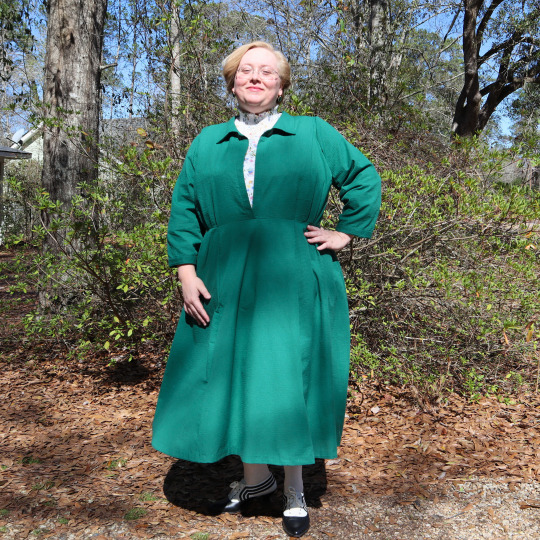

Next pattern is from this antique 1918-19 day dress with a 57” (145cm) bust / 46.5” (118cm) waist / 52” (132) hips! The original is made of a cotton fabric with velvet flocking in vermicelli patterns – quite stylish in the 1910s.
(In the green dress is tester @/rebecca.pocket.full.of.poseys (IG), who enlarged it slightly in the waist and added quite a bit to the hips to fit her curvy figure.)
Available on Etsy here!
19 notes
·
View notes
Text

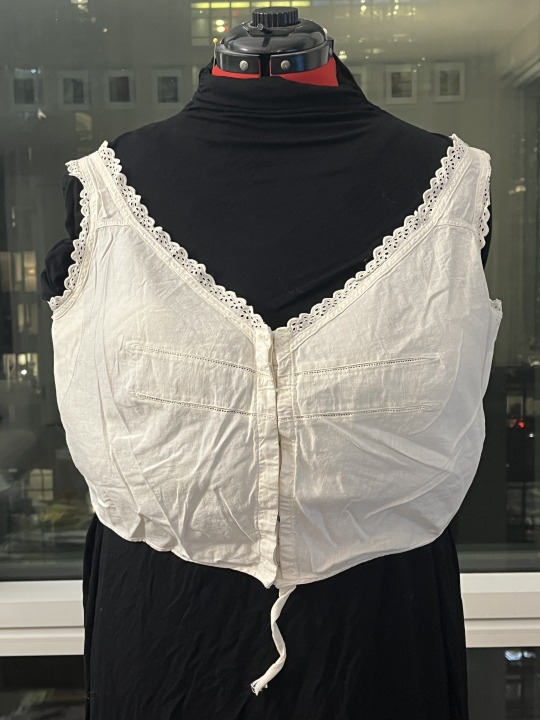

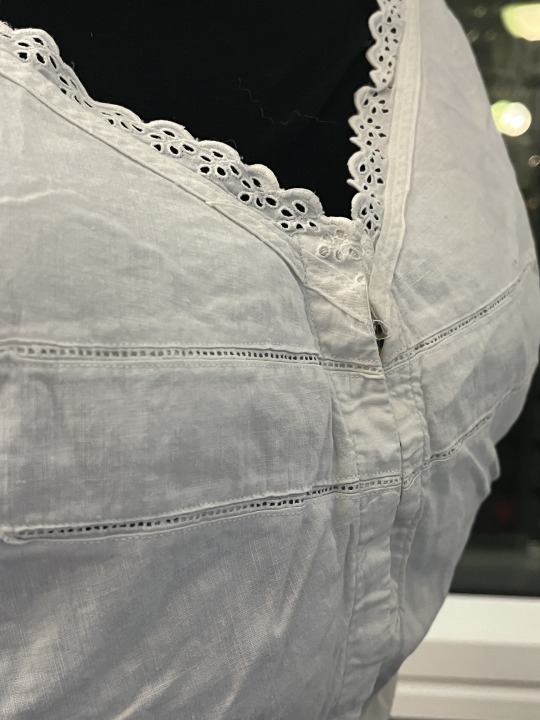
On a roll! This pattern is [CLOSED] for testers - the original garment is a c. 1910 brassiere (or corset cover) with a 47” (119cm) bust and 40” (101cm) high waist. It’s deceptively simple - that cross-bust entredeux lace hides two pairs of darts, and there’s also an appliquéd underarm guard. I’m definitely going to make a version for myself at some point <3
Edit: Now on Etsy here!
I received some tester photos back but none of them are actually the right size for this garment, so holding off on posting them here. (Both have large busts and comparatively small waists, so while they can wear it, it doesn't fit them as it should.)
#now up on etsy!! a bit cheaper than the other patterns#historical patterns#plus size patterns#historical garments#historical underwear#edwardian fashion#1910s fashion
101 notes
·
View notes
Text
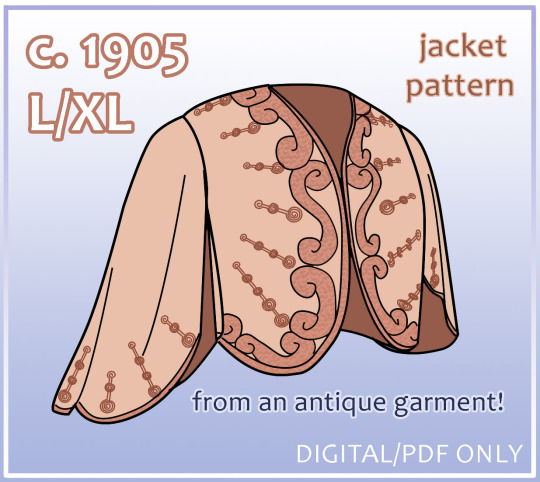


New pattern now in testing phase! If all goes well, this'll be up on Etsy in a couple of weeks.
The original garment is a c. 1905 wool, velvet, and chenille-embroidered jacket (suitable for a walking ensemble or dinner dress alike - it probably would have gone over a pretty shirtwaist & had a matching skirt) with a 40” (101cm) bust & max waist of 36" (91cm).
I tried on a mockup and the back fits very well, so I’m calling this an L/XL size and have included a bust extension to 43”, though this can also be worn open for larger busts.
Edit: Available on Etsy here! <3
274 notes
·
View notes
Note
@chasingtheskyline - Once you leave the realm of super-rich, women definitely bowed to practicality, so follow your needs!
From my collection:

c. 1905 RPCC

c. 1914 RPCC
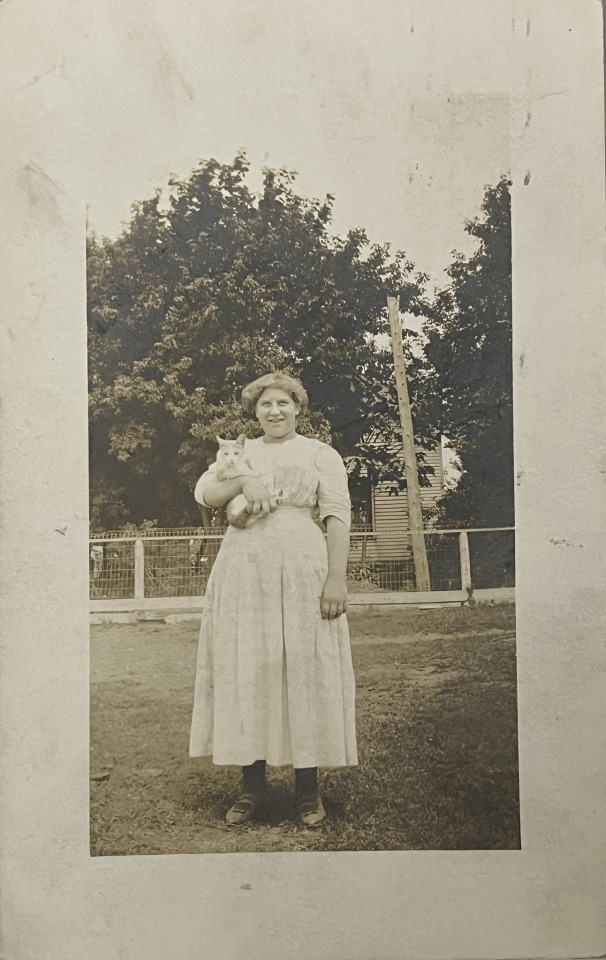
Laura Lemke & her cat, 1911
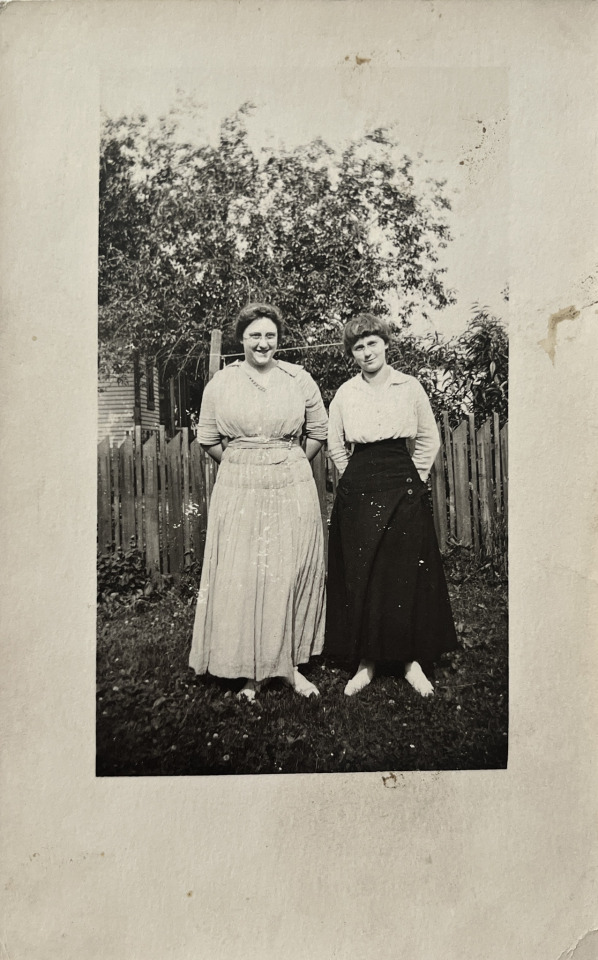
c. 1911 RPCC

c. 1910 RPCC
Etc. - I have many more images in the gallery these link to if you'd like to browse, though the date range is much larger. (Some photos of disabled women as well, but none with particularly short skirts.) Of the c. 1910 photos of women dressed more fashionably, most of them have instep- or ankle-length skirts.

c. 1913 RPCC
Hope this helps?
(Please don't reshare without links!)
Do you have any ideas/evidence as to how skirt length varied for women with limps/disabilities? I'm planning and making a historybounding wardrobe for around 1900-1908, and I am feeling the need to make my skirts, instead of instep length, around ankle-bone length or slightly shorter even than that, just so I don't trip and rip my hems out - at my height it's between 32 and 34 inches. I'm using a lot of plates for "Toilettes de jeune femme ou de jeune fille" for inspo because as a petite 24 year old who looks 16, I can still do that. Looking at various photos of actual normal women it wasn't horribly uncommon to make your skirts four or five or even six inches above the ground, but in high fashion I am drawn to the more sporty skirt styles and evening skirts for dancing for this reason. All of the recorded catalogue skirts are made quite long for quite tall people - to be hemmed as desired.
The thermoregulation is so good with historical dress that if I wear certain underwear and layer properly, I don't get full body spasms and pain at the slightest breeze. It's lovely, but I also need to get around effectively.
I'm so glad it works well for you re: thermoregulation! And of course, being in fact a modern lady, you're not bound to strict historical accuracy if you need to modify things to allow for easier movement.
(Even most normal- non-rich, I imagine you mean? -women often wore instep-length skirts, though, with modifications as needed for work and/or sporting activities. That's probably where you're seeing the shorter hems)
Women with mobility issues did exist back then, of course, but I'm afraid I don't know much about how they may have modified their skirts. Princess Alexandra had a limp after a bout of post-partum rheumatic fever left her with a stiff leg in 1867, but her skirts generally seem to be of normal length in photos. Of course, those are official portraits, and her nature as a public figure means that any image of her would be tightly controlled. she couldn't avoid limping in IRL public appearances, though, which I assume is how it was known generally. there's a rumor that ladies began limping on purpose to copy her, for Fashion Reasons, but that sounds a bit far-fetched to me.
I'd imagine that, much like in working situations, the rule was "practicality first?" Sorry I couldn't be more helpful on the history here!
#1910s fashion#1900s fashion#vintage postcards#vintage fashion#stout style history#fat fashion history#FYI RPCC means real photo postcard - it was a photography format for quick photos#and there are so many here bc they proliferated around 1910 and were very cheap! so it's more common to see full lengths and candids &-#-outdoor photos as RPCCs (as opposed to regular photography#they are FANTASTIC for seeing how ordinary people dressed!
103 notes
·
View notes
Text






Next pattern is from this antique 1918-19 day dress with a 57” (145cm) bust / 46.5” (118cm) waist / 52” (132) hips! The original is made of a cotton fabric with velvet flocking in vermicelli patterns – quite stylish in the 1910s.
(In the green dress is tester @/rebecca.pocket.full.of.poseys (IG), who enlarged it slightly in the waist and added quite a bit to the hips to fit her curvy figure.)
Available on Etsy here!
19 notes
·
View notes
Text
1880s pattern is finally done and available! https://www.etsy.com/listing/1643794747/1880s-lxl-day-bodice-pdf-pattern-with-32

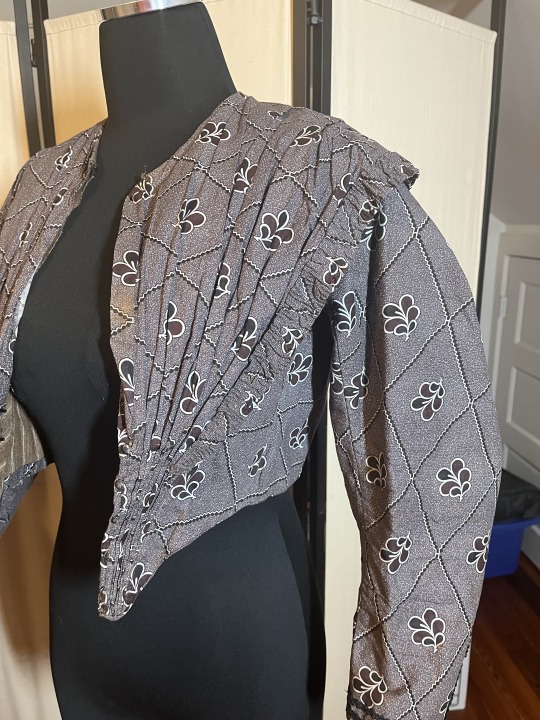

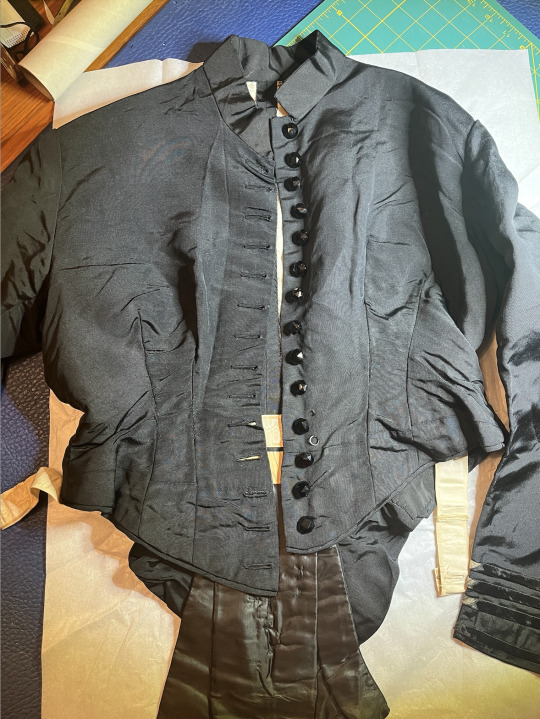

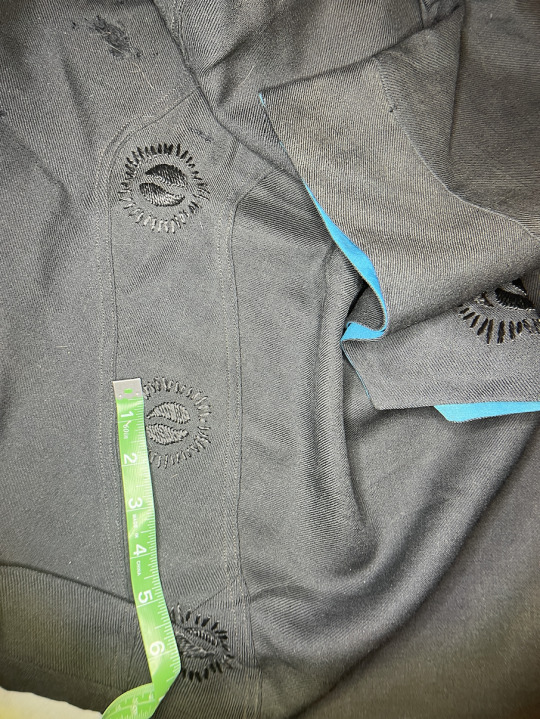
The past week's work: three digitized patterns from antique garments!
- The 1840s bodice is 34/36" bust - 31" waist (pattern HERE)
- The 1880s is 44" bust - 32" waist (pattern HERE)
- the 1920s dress is 47" bust - 48" waist (pattern HERE)
All three patterns are currently with testers for the next two weeks and after that I will be able to put them up on Etsy!
I have seven other antiques waiting for patterning (and two more on the way) - just have to decide what to work on next....
239 notes
·
View notes
Text


Open for testers! 📣 This lovely 1905-6 cotton sateen blouse waist is a 49” (124cm) bust, and the waist is free as the pleating isn’t secured except at the back (it ties shut/gets tucked into the skirt). It’s got a lace yoke, box-pleats at front and back, and gorgeous pin-tucked sleeves. ✨ Forgive me for making it yellow in the thumbnail, but I wanted to showcase the details lol. DM me if you’re interested in testing.
Available on Etsy here!
28 notes
·
View notes
Text




On a roll! This pattern is [CLOSED] for testers - the original garment is a c. 1910 brassiere (or corset cover) with a 47” (119cm) bust and 40” (101cm) high waist. It’s deceptively simple - that cross-bust entredeux lace hides two pairs of darts, and there’s also an appliquéd underarm guard. I’m definitely going to make a version for myself at some point <3
Edit: Now on Etsy here!
I received some tester photos back but none of them are actually the right size for this garment, so holding off on posting them here. (Both have large busts and comparatively small waists, so while they can wear it, it doesn't fit them as it should.)
#24.10#historical underwear#antique garments#edwardian fashion#1910s fashion#1900s fashion#plus size patterns#historical patterns
101 notes
·
View notes
Text



New pattern now in testing phase! If all goes well, this'll be up on Etsy in a couple of weeks.
The original garment is a c. 1905 wool, velvet, and chenille-embroidered jacket (suitable for a walking ensemble or dinner dress alike - it probably would have gone over a pretty shirtwaist & had a matching skirt) with a 40” (101cm) bust & max waist of 36" (91cm).
I tried on a mockup and the back fits very well, so I’m calling this an L/XL size and have included a bust extension to 43”, though this can also be worn open for larger busts.
Edit: Available on Etsy here! <3
274 notes
·
View notes
Text
youtube
Rebecca of Pocket Full of Poseys just put out a video on making the 1910s dressing jacket! <3
8 notes
·
View notes
Text
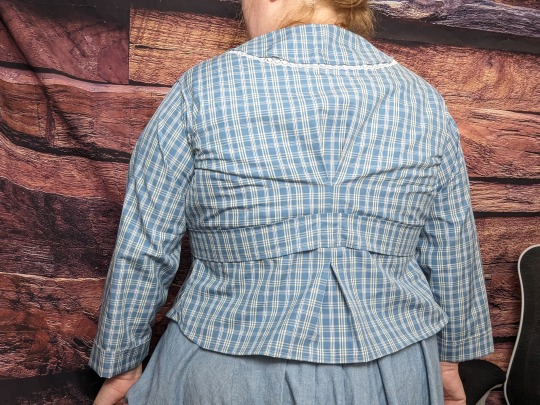



The 1910s dressing jacket pattern is now up!
Here are two tester makes of the unaltered pattern - Jean Sando (in the dark blue) has a 48" bust and 43" waist, and Rebecca (@/rebecca.pocket.full.of.poseys, light blue) has a 54" bust and 50" waist.
Testers commented that the waist is pretty high (makes sense, since this is c.1910) so anyone making this should check the height and consider lowering the back pleating & belt attachment point if needed.
[The original garment is an antique size 52 - the max bust is 60.5” (154cm) & max waist is 56.25” (143cm), but there's supposed to be a bunch of ease so the suggested wearer bust is 52” (132cm) and waist 42.5” (108cm).]
Pattern available here:
25 notes
·
View notes
